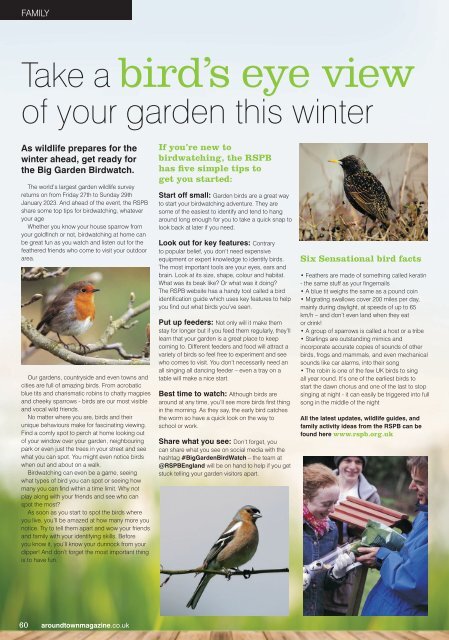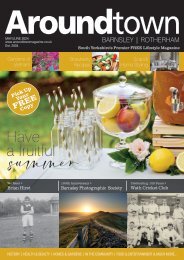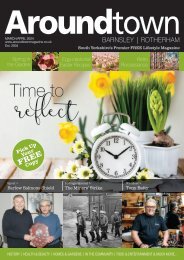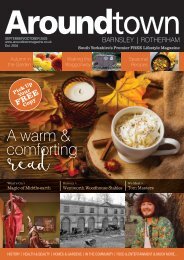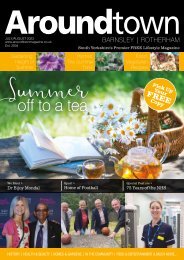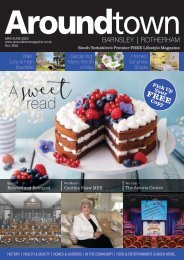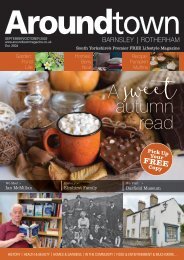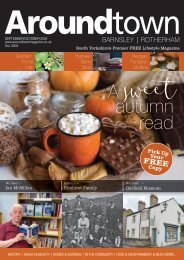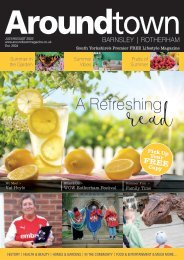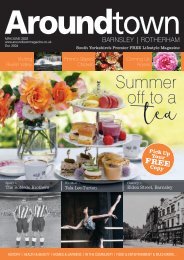Aroundtown Magazine November/December 2022 Edition
The bumper festive edition of Aroundtown Magazine, South Yorkshire's premier free lifestyle magazine
The bumper festive edition of Aroundtown Magazine, South Yorkshire's premier free lifestyle magazine
Create successful ePaper yourself
Turn your PDF publications into a flip-book with our unique Google optimized e-Paper software.
FAMILY<br />
Take a bird’s eye view<br />
of your garden this winter<br />
As wildlife prepares for the<br />
winter ahead, get ready for<br />
the Big Garden Birdwatch.<br />
The world’s largest garden wildlife survey<br />
returns on from Friday 27th to Sunday 29th<br />
January 2023. And ahead of the event, the RSPB<br />
share some top tips for birdwatching, whatever<br />
your age<br />
Whether you know your house sparrow from<br />
your goldfinch or not, birdwatching at home can<br />
be great fun as you watch and listen out for the<br />
feathered friends who come to visit your outdoor<br />
area.<br />
Our gardens, countryside and even towns and<br />
cities are full of amazing birds. From acrobatic<br />
blue tits and charismatic robins to chatty magpies<br />
and cheeky sparrows - birds are our most visible<br />
and vocal wild friends.<br />
No matter where you are, birds and their<br />
unique behaviours make for fascinating viewing.<br />
Find a comfy spot to perch at home looking out<br />
of your window over your garden, neighbouring<br />
park or even just the trees in your street and see<br />
what you can spot. You might even notice birds<br />
when out and about on a walk.<br />
Birdwatching can even be a game, seeing<br />
what types of bird you can spot or seeing how<br />
many you can find within a time limit. Why not<br />
play along with your friends and see who can<br />
spot the most?<br />
As soon as you start to spot the birds where<br />
you live, you’ll be amazed at how many more you<br />
notice. Try to tell them apart and wow your friends<br />
and family with your identifying skills. Before<br />
you know it, you’ll know your dunnock from your<br />
dipper! And don’t forget the most important thing<br />
is to have fun.<br />
If you’re new to<br />
birdwatching, the RSPB<br />
has five simple tips to<br />
get you started:<br />
Start off small: Garden birds are a great way<br />
to start your birdwatching adventure. They are<br />
some of the easiest to identify and tend to hang<br />
around long enough for you to take a quick snap to<br />
look back at later if you need.<br />
Look out for key features: Contrary<br />
to popular belief, you don’t need expensive<br />
equipment or expert knowledge to identify birds.<br />
The most important tools are your eyes, ears and<br />
brain. Look at its size, shape, colour and habitat.<br />
What was its beak like? Or what was it doing?<br />
The RSPB website has a handy tool called a bird<br />
identification guide which uses key features to help<br />
you find out what birds you’ve seen.<br />
Put up feeders: Not only will it make them<br />
stay for longer but if you feed them regularly, they’ll<br />
learn that your garden is a great place to keep<br />
coming to. Different feeders and food will attract a<br />
variety of birds so feel free to experiment and see<br />
who comes to visit. You don’t necessarily need an<br />
all singing all dancing feeder – even a tray on a<br />
table will make a nice start.<br />
Best time to watch: Although birds are<br />
around at any time, you’ll see more birds first thing<br />
in the morning. As they say, the early bird catches<br />
the worm so have a quick look on the way to<br />
school or work.<br />
Share what you see: Don’t forget, you<br />
can share what you see on social media with the<br />
hashtag #BigGardenBirdWatch – the team at<br />
@RSPBEngland will be on hand to help if you get<br />
stuck telling your garden visitors apart.<br />
Six Sensational bird facts<br />
• Feathers are made of something called keratin<br />
- the same stuff as your fingernails<br />
• A blue tit weighs the same as a pound coin<br />
• Migrating swallows cover 200 miles per day,<br />
mainly during daylight, at speeds of up to 65<br />
km/h – and don’t even land when they eat<br />
or drink!<br />
• A group of sparrows is called a host or a tribe<br />
• Starlings are outstanding mimics and<br />
incorporate accurate copies of sounds of other<br />
birds, frogs and mammals, and even mechanical<br />
sounds like car alarms, into their song<br />
• The robin is one of the few UK birds to sing<br />
all year round. It’s one of the earliest birds to<br />
start the dawn chorus and one of the last to stop<br />
singing at night - it can easily be triggered into full<br />
song in the middle of the night<br />
All the latest updates, wildlife guides, and<br />
family activity ideas from the RSPB can be<br />
found here www.rspb.org.uk<br />
60 aroundtownmagazine.co.uk


